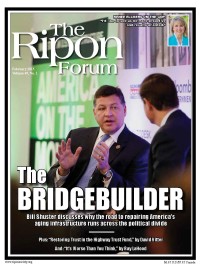
The country changes quickly. Congress moves slowly. This presents a classic policy problem where we find ourselves spending federal tax dollars ineffectively because of a policy that has become outdated and in need of reform. In the case of federal transportation spending, the country changed long ago and the reform is overdue.
Reform is overdue in part because Congress itself was the major beneficiary of the outdated system. The original purpose of the federal surface transportation program was to construct the Interstate Highway System (IHS). The program is funded by a federal gas tax, which deposits monies into the Highway Trust Fund (HTF). Over time, the program began to encompass many other purposes, including other roads, transit systems, and transportation research, thus expanding the constituencies supporting the program. Congress benefitted not only from bringing home revenues to states and districts for transportation generally, but also from earmarking funds for specific projects. This provided little incentive for wholesale reform.
Change, however, is greatly needed. First, the vast majority (approximately 92%) of federal surface transportation funding is distributed by formula to states with little or no accountability as to whether that money is achieving any specific national goal. While grantees are required to spend different buckets of money on different infrastructure – some on the IHS, some on transit, etc. – they are not required to prioritize or justify investments based on cost benefit analysis or any larger purpose. Thanks to the latest surface transportation bill, Moving Ahead for Progress in the 21st Century (MAP-21), they are required to set targets for specific performance measures. But they can set those targets as they please, and there is no reward or consequence for failing to meet those targets.
The vast majority (approximately 92%) of federal surface transportation funding is distributed by formula to states with little or no accountability as to whether that money is achieving any specific national goal.
Second, the program is far too focused on capital investment and construction. When the program was intended to build a national system of highways this made sense. But now our system is largely built-out, and instead of new capital we need effective maintenance and operational strategies that help us extract greater value from the initial investment.
Finally, the program is no longer financially sustainable. Congress has consistently planned, since 2005, to spend more on transportation than they take in. This has resulted in a series of general fund bailouts of the HTF since 2008, at a rate of almost one per year. Congress and our two most recent Presidents have shown no interest or willingness to raise the gas tax, and have declined to develop an alternative source of consistent revenue for transportation. The result is that states and other grantees face continuous uncertainty regarding whether the federal share of their capital transportation budgets, approximately 45%, is going to materialize. This hinders both long-term planning and wise investment decisions.
Wholesale reform of this program will take time. But there are some actions Congress can take immediately to make improvements. These include the following:
Make more funding available through discretionary grant programs. Formula funding is necessary in order to help states and localities maintain their highway and transit systems. But federal money should also be targeted towards national priorities, and discretionary programs with a role for Congress and the Executive have proven most effective way to do that. Some obvious federal priorities based on the national goals specified in MAP-21 include freight, system reliability, and environmental outcomes. Discretionary programs targeting these goals, with specific performance measures intended to evaluate proposals from states and localities on an objective basis, could provide an improved return on federal investment.
New innovations in operations such as congestion pricing, intelligent transportation systems, and shared-use mobility are more likely to become reality when federal money is there to incentivize their development.
Use those programs to incentivize innovation and revenue. Discretionary grant programs can do more than target funding towards national transportation goals – they can also provide incentives for states and localities to take greater political risks. Raising revenues for transportation is always challenging politically, but when federal dollars can reward increased investment it becomes easier. Similarly, new innovations in operations such as congestion pricing, intelligent transportation systems, and shared-use mobility are more likely to become reality when federal money is there to incentivize their development. A federal role in providing incentives for things states and localities want to do — but face political barriers to accomplishing — is potentially a very effective one.
Decide on a permanent funding source. The federal transportation program will not be effective if funding for it continues to be cobbled together every year, or even every few years. In order to provide stability, Congress should determine a consistent funding source for transportation. If increasing the gas tax is politically impossible, as it appears to be, it is time to admit that and move on. Congress should dedicate existing gas tax revenues to formula programs that provide funding for system preservation, and commit to providing general funds for new discretionary grant programs. Even if the total amount available for these programs might vary, a commitment to a funding source for the long-term would be a substantial improvement over existing instability.
Joshua Schank is the President and CEO of the Eno Center for Transportation.




